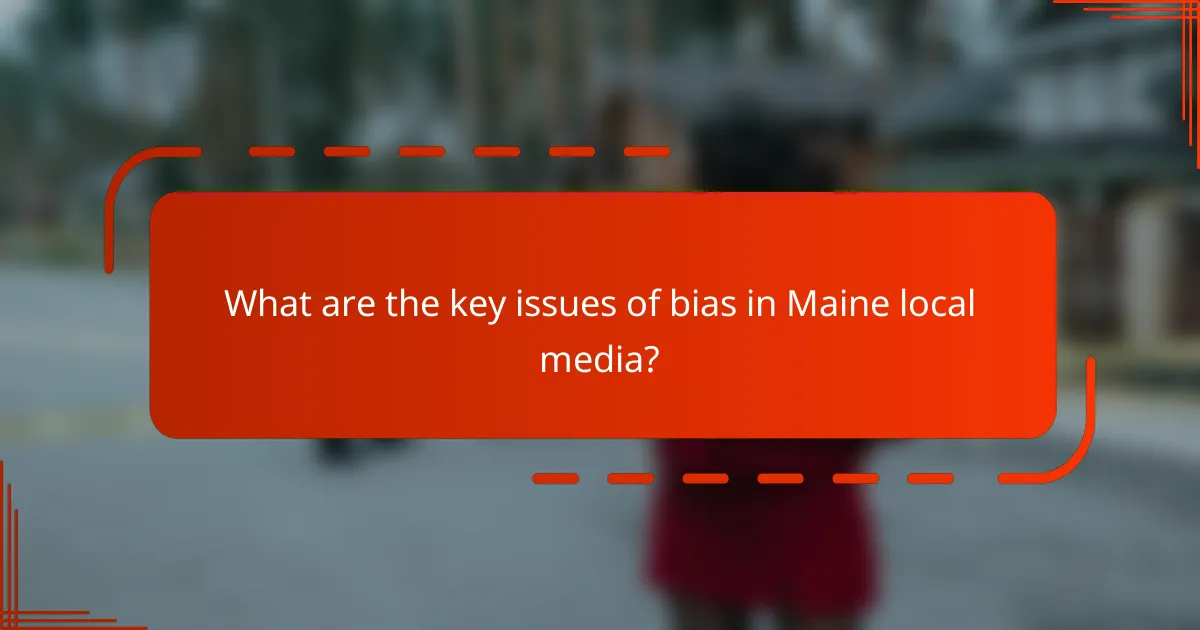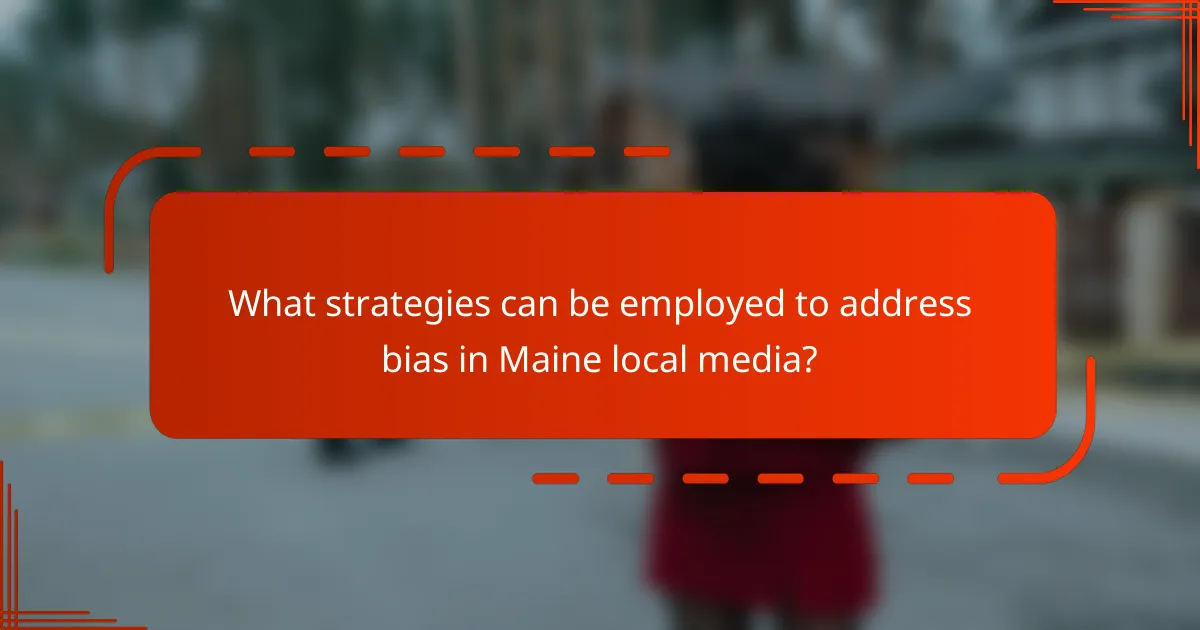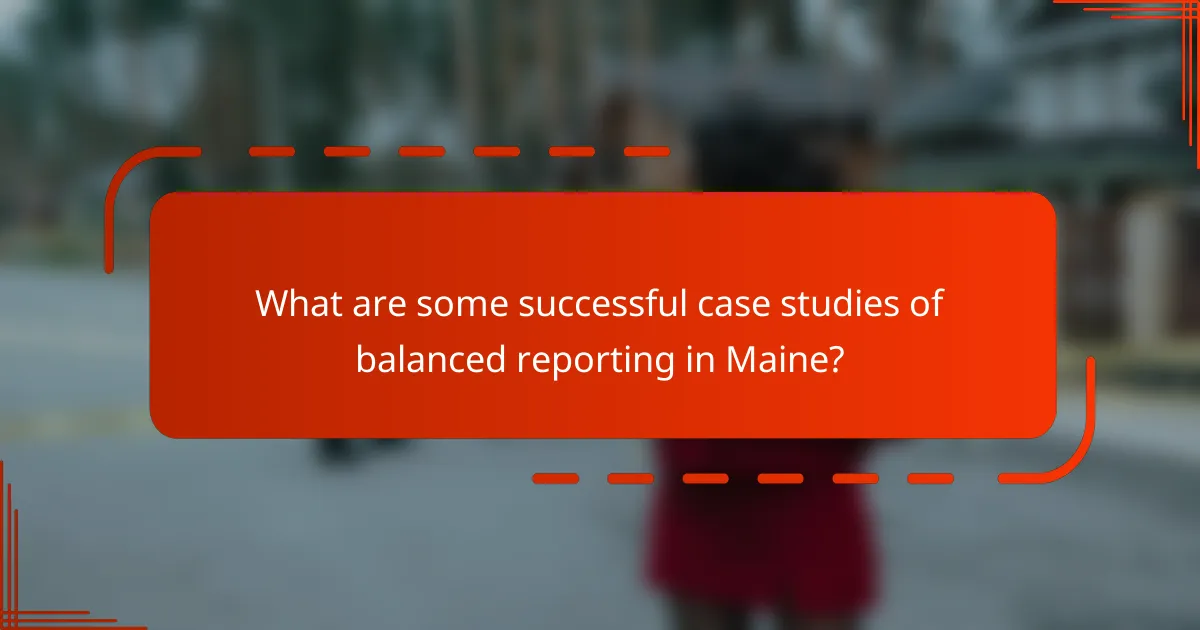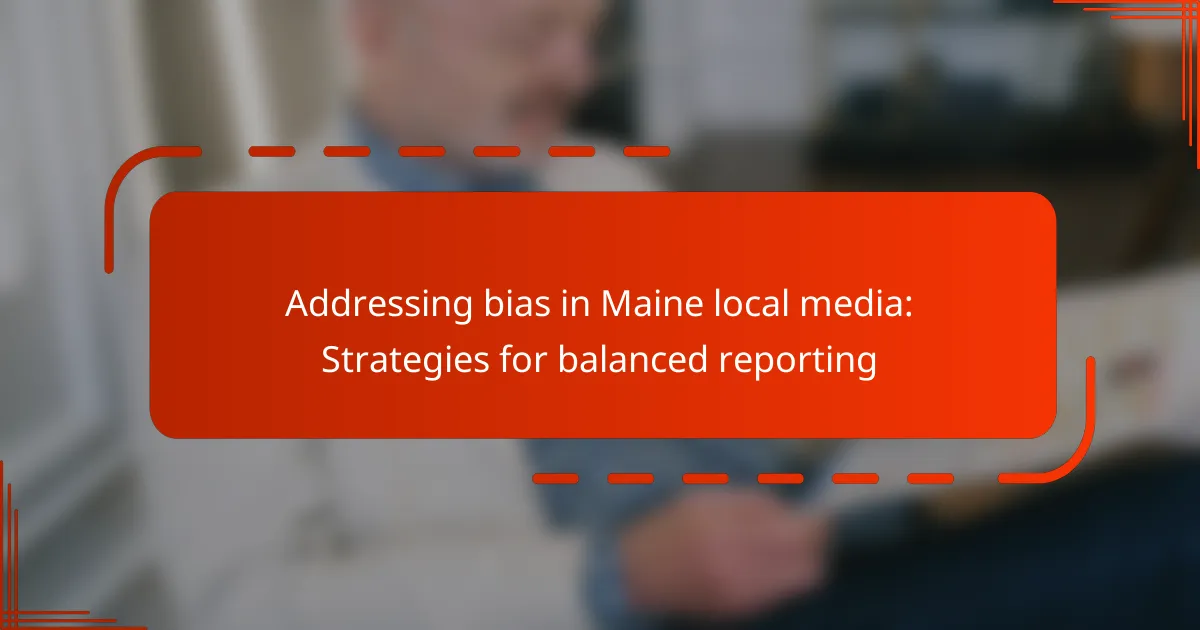The article addresses bias in Maine local media, focusing on key issues such as political partisanship, selective reporting, and a lack of diversity in perspectives. It highlights how these biases can affect public perception and trust in local news, as reported by the Maine Media Literacy Project. Strategies for promoting balanced reporting include implementing training programs for journalists, encouraging diverse hiring practices, establishing editorial guidelines for fairness, and engaging with the community for feedback. The article emphasizes the importance of accountability and transparency in media practices to enhance the integrity of local news coverage.

What are the key issues of bias in Maine local media?
Key issues of bias in Maine local media include political partisanship, selective reporting, and lack of diversity in perspectives. Political partisanship can lead to coverage that favors one side of an issue over another. Selective reporting often results in the omission of important context or viewpoints. Furthermore, a lack of diversity in media ownership and staffing can limit the range of voices and experiences represented. According to a 2020 report by the Maine Media Literacy Project, these biases can impact public perception and trust in local news. This report highlights the need for greater accountability and transparency in reporting practices to ensure balanced coverage.
How does bias manifest in local news reporting?
Bias manifests in local news reporting through selective coverage, framing, and language choices. Selective coverage occurs when certain events or issues receive more attention than others, leading to an imbalanced portrayal of reality. For example, a study by the Pew Research Center found that local news often highlights crime stories, which can skew public perception of safety. Framing involves presenting information in a way that influences interpretation. A report may highlight negative aspects of a community while downplaying positive developments. Language choices can also reflect bias; for instance, using emotionally charged words can sway audience opinions. Overall, these manifestations of bias can shape public understanding and community perceptions significantly.
What are common examples of bias in Maine media?
Common examples of bias in Maine media include political bias, regional bias, and socioeconomic bias. Political bias often manifests in the framing of news stories that favor one political party over another. For instance, coverage of local elections may highlight the achievements of Democratic candidates while downplaying those of Republicans. Regional bias can occur when media outlets focus more on urban areas like Portland, neglecting rural communities. This can lead to an underrepresentation of issues affecting those rural populations. Socioeconomic bias may be observed in the portrayal of economic issues, where affluent communities receive more attention than lower-income areas. Reports on welfare programs may also reflect negative stereotypes about recipients. These biases can shape public perception and influence community discourse.
How does bias affect public perception of news?
Bias significantly influences public perception of news by shaping how information is presented and interpreted. When news outlets exhibit bias, they often highlight certain facts while downplaying others. This selective reporting can lead to a skewed understanding of events. Research shows that biased coverage can reinforce existing beliefs and attitudes among audiences. For instance, studies indicate that individuals are more likely to trust news that aligns with their preconceptions. Consequently, this can create echo chambers, where contrasting viewpoints are marginalized. The result is a polarized public, with differing interpretations of the same news story. Ultimately, bias can distort reality and hinder informed public discourse.
Why is balanced reporting important for local communities?
Balanced reporting is important for local communities because it ensures diverse perspectives are represented. This representation fosters informed decision-making among residents. It helps build trust in local media sources. According to a study by the Pew Research Center, communities with balanced news coverage report higher levels of civic engagement. Balanced reporting also mitigates the spread of misinformation. It encourages dialogue and understanding among different community groups. This approach ultimately strengthens community cohesion and resilience.
What role does local media play in shaping community opinions?
Local media plays a crucial role in shaping community opinions. It serves as a primary source of information for residents. Local media outlets report on issues that directly affect the community. They highlight local events, government actions, and social issues. This coverage influences public perception and community discussions. Research indicates that local news can significantly impact civic engagement. For instance, communities with robust local media have higher voter turnout rates. Additionally, local media provides a platform for diverse voices and opinions. This inclusivity fosters a more informed and engaged citizenry.
How can bias impact community trust in media outlets?
Bias can significantly undermine community trust in media outlets. When media outlets exhibit bias, they often present information in a skewed manner. This can lead to perceptions of unfairness and manipulation among the audience. Research shows that 62% of Americans believe news organizations are biased in their reporting. Such perceptions can foster skepticism and disengagement from media sources. Communities may turn to alternative outlets that align with their views, further polarizing public opinion. In turn, this can create echo chambers, diminishing the diversity of perspectives. Trust is essential for effective communication between media and the public. Without it, media outlets may struggle to fulfill their role as reliable information sources.

What strategies can be employed to address bias in Maine local media?
Implementing training programs for journalists can address bias in Maine local media. These programs should focus on recognizing and mitigating personal biases. Encouraging diverse hiring practices is another effective strategy. A diverse newsroom can provide varied perspectives. Establishing editorial guidelines that promote fairness is crucial. These guidelines should emphasize fact-checking and balanced reporting. Engaging with the community can also help. Community feedback can highlight perceived biases and improve trust. Collaborating with independent watchdog organizations can enhance accountability. These organizations can provide oversight and foster transparency in reporting.
How can media organizations implement training for journalists?
Media organizations can implement training for journalists through structured programs and workshops. These programs should focus on ethics, fact-checking, and bias recognition. Regular training sessions can enhance journalists’ skills in balanced reporting. Mentorship opportunities can pair experienced journalists with newcomers. Online resources and courses can provide accessible learning options. Collaboration with academic institutions can bring expert insights into the training. Feedback mechanisms can help evaluate the effectiveness of training initiatives. Continuous assessment ensures that journalists stay updated on best practices.
What topics should be covered in bias training sessions?
Bias training sessions should cover topics such as understanding implicit bias, recognizing systemic discrimination, and exploring cultural competency. These sessions should also address the impact of bias on decision-making and reporting. Furthermore, they should include strategies for mitigating bias in journalism. Practical exercises for identifying bias in media content are essential. Discussions on ethical reporting standards and accountability in journalism should be included. Finally, sessions should emphasize the importance of diverse perspectives in reporting.
How can ongoing education help sustain balanced reporting?
Ongoing education helps sustain balanced reporting by equipping journalists with updated skills and knowledge. It fosters awareness of biases and encourages critical thinking. Training programs can include workshops on ethics and diversity in reporting. These programs promote understanding of various perspectives and communities. Research shows that educated journalists are more likely to produce fair and accurate content. Studies indicate that ongoing training leads to improved reporting standards. For example, the Pew Research Center highlights that media literacy enhances public trust in journalism. Thus, continuous education is essential for maintaining objectivity in reporting.
What role do community feedback and engagement play?
Community feedback and engagement play a crucial role in addressing bias in local media. They provide essential insights into public perceptions and concerns. Engaging with the community fosters transparency and accountability in reporting. Feedback helps media outlets identify potential biases in their coverage. It also encourages diverse viewpoints, enriching the narrative presented to the audience. Studies show that media organizations that actively seek community input produce more balanced reporting. This approach helps build trust between the media and the community. Trust is vital for effective communication and information dissemination.
How can local audiences provide constructive feedback on media coverage?
Local audiences can provide constructive feedback on media coverage through various channels. They can write letters to the editor to express their views. Engaging on social media platforms allows for public discussions about media content. Participating in community forums hosted by media outlets fosters direct dialogue. Submitting feedback forms on news websites enables structured responses. Emailing journalists or editors directly facilitates personalized communication. Surveys conducted by media organizations can gather audience insights. These methods encourage accountability and can influence future reporting. Constructive feedback has been shown to improve media practices and enhance community trust.
What methods can media outlets use to engage with their audience effectively?
Media outlets can engage with their audience effectively through interactive content, social media engagement, and audience feedback. Interactive content includes polls, quizzes, and live Q&A sessions that invite participation. Social media engagement allows media outlets to share content and respond to comments in real-time. Audience feedback can be gathered through surveys and comment sections, enabling outlets to understand viewer preferences. According to a 2021 study by the Pew Research Center, 53% of Americans prefer news organizations that allow audience interaction. This demonstrates that engagement methods can enhance audience loyalty and trust.

What are some successful case studies of balanced reporting in Maine?
It is not possible to provide specific successful case studies of balanced reporting in Maine. There is a lack of publicly available, detailed documentation on specific instances. Additionally, individual media outlets may not publicly disclose their internal processes or outcomes related to balanced reporting.
How have certain media outlets successfully reduced bias?
Certain media outlets have successfully reduced bias by implementing transparent editorial guidelines. These guidelines promote fairness and objectivity in reporting. Outlets often engage diverse editorial teams to reflect various perspectives. This practice helps mitigate individual biases in news coverage. Additionally, some outlets conduct regular bias training for journalists. This training educates staff on recognizing and minimizing personal biases. Research indicates that transparency increases audience trust and credibility. For example, a study by the American Press Institute found that transparency in sourcing enhances perceived reliability.
What specific strategies did these outlets implement?
Maine local media outlets implemented several strategies to address bias and ensure balanced reporting. They conducted regular bias training for journalists to enhance awareness and understanding. These outlets also established editorial guidelines focused on impartiality and fact-checking. Collaboration with diverse community groups helped them gain varied perspectives. They utilized audience feedback to adjust content and improve representation. Implementing transparency measures, such as disclosing sources and funding, built trust with the audience. Furthermore, they promoted diverse hiring practices to reflect the community’s demographics in their reporting.
What outcomes resulted from these changes in reporting practices?
Changes in reporting practices led to improved accuracy and credibility in Maine local media. These adjustments reduced instances of bias, resulting in more balanced news coverage. Audience trust in local media increased as a result of these changes. Additionally, community engagement grew, with more residents participating in discussions around local issues. Fact-checking became more prevalent, enhancing the overall quality of reporting. These outcomes reflect a positive shift towards responsible journalism in the region.
What best practices can be adopted for future reporting?
Adopting best practices for future reporting involves implementing strategies that enhance objectivity and accuracy. First, journalists should prioritize fact-checking before publication. This ensures that all information presented is verified and credible. Second, diverse sourcing is crucial. Engaging with a wide range of voices and perspectives can mitigate bias. Third, transparency in reporting methods builds trust with the audience. Clearly outlining the process of information gathering can enhance credibility. Fourth, training on media literacy for reporters is beneficial. Continuous education helps journalists recognize and counteract their own biases. Finally, audience feedback mechanisms can provide insights into perceived biases. Incorporating community input fosters accountability and improves reporting quality.
How can local media continuously assess and improve their reporting standards?
Local media can continuously assess and improve their reporting standards by implementing regular evaluations of their content. They should establish clear criteria for accuracy, fairness, and balance in reporting. Conducting audience surveys can provide valuable feedback on perceived biases and areas for improvement. Collaborating with fact-checking organizations can enhance credibility and ensure factual accuracy. Training sessions for journalists on ethics and bias recognition can foster a culture of accountability. Additionally, reviewing analytics data can help identify trends in audience engagement and content effectiveness. These practices collectively contribute to maintaining high reporting standards and addressing bias effectively.
What resources are available for maintaining balanced journalism?
Resources for maintaining balanced journalism include training programs, ethical guidelines, and fact-checking tools. Organizations like the Society of Professional Journalists provide ethical standards that guide reporters. Workshops and seminars can enhance skills in unbiased reporting. Fact-checking websites like Snopes and FactCheck.org help verify information. Media literacy resources educate the public on recognizing bias. Collaborative networks among journalists promote sharing best practices. Research studies, such as those from the Pew Research Center, offer insights into media consumption and bias. These resources collectively support efforts to achieve balanced journalism.
The main entity of the article is bias in Maine local media. The article examines key issues related to bias, including political partisanship, selective reporting, and lack of diverse perspectives, which can distort public perception and trust in local news. It outlines how bias manifests in reporting through selective coverage, framing, and language choices, and discusses the importance of balanced reporting for community engagement and informed decision-making. Strategies to address bias, such as training for journalists, community feedback, and diverse hiring practices, are also highlighted, emphasizing the role of transparency and accountability in fostering trust between media outlets and the public.
